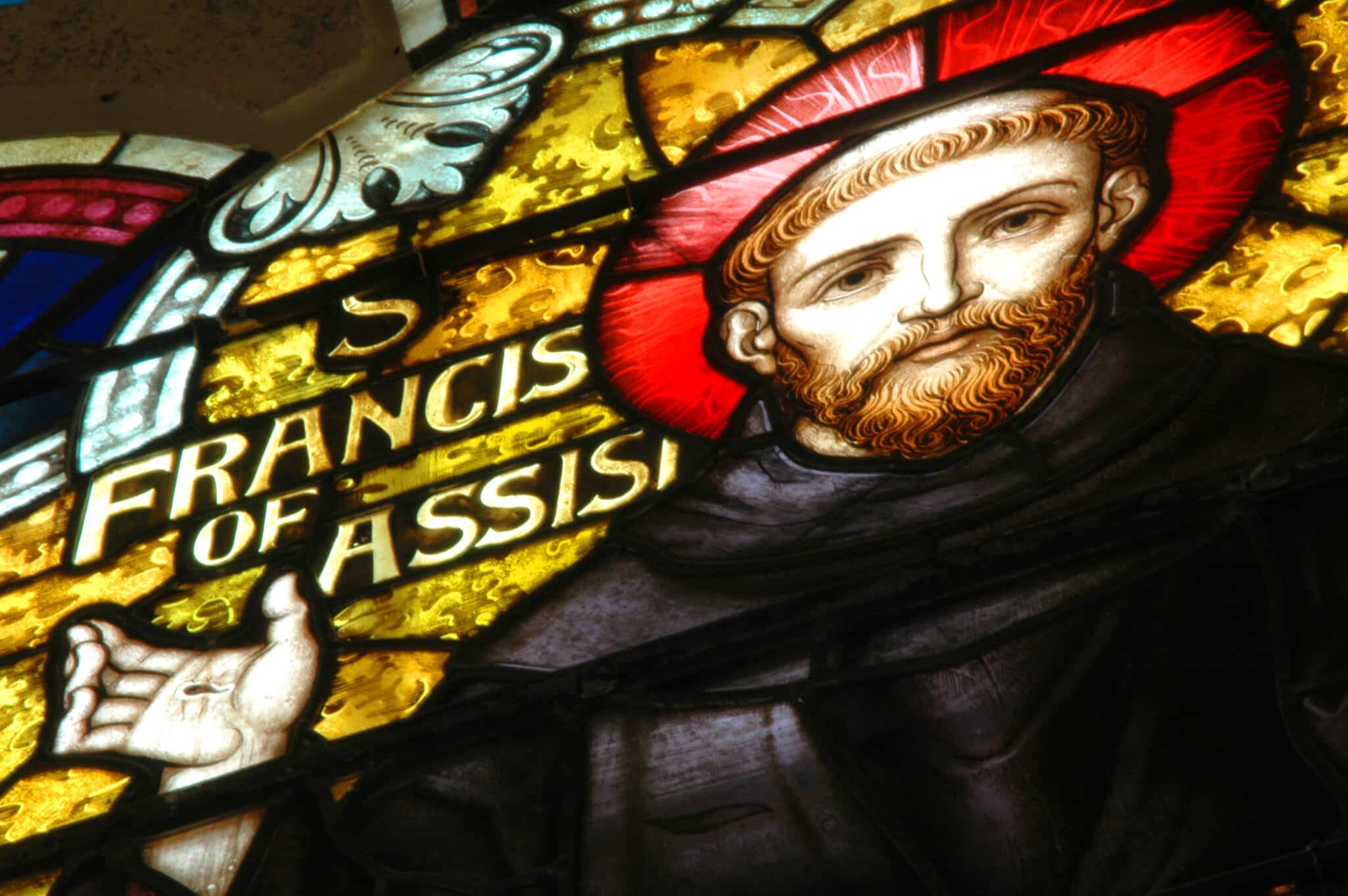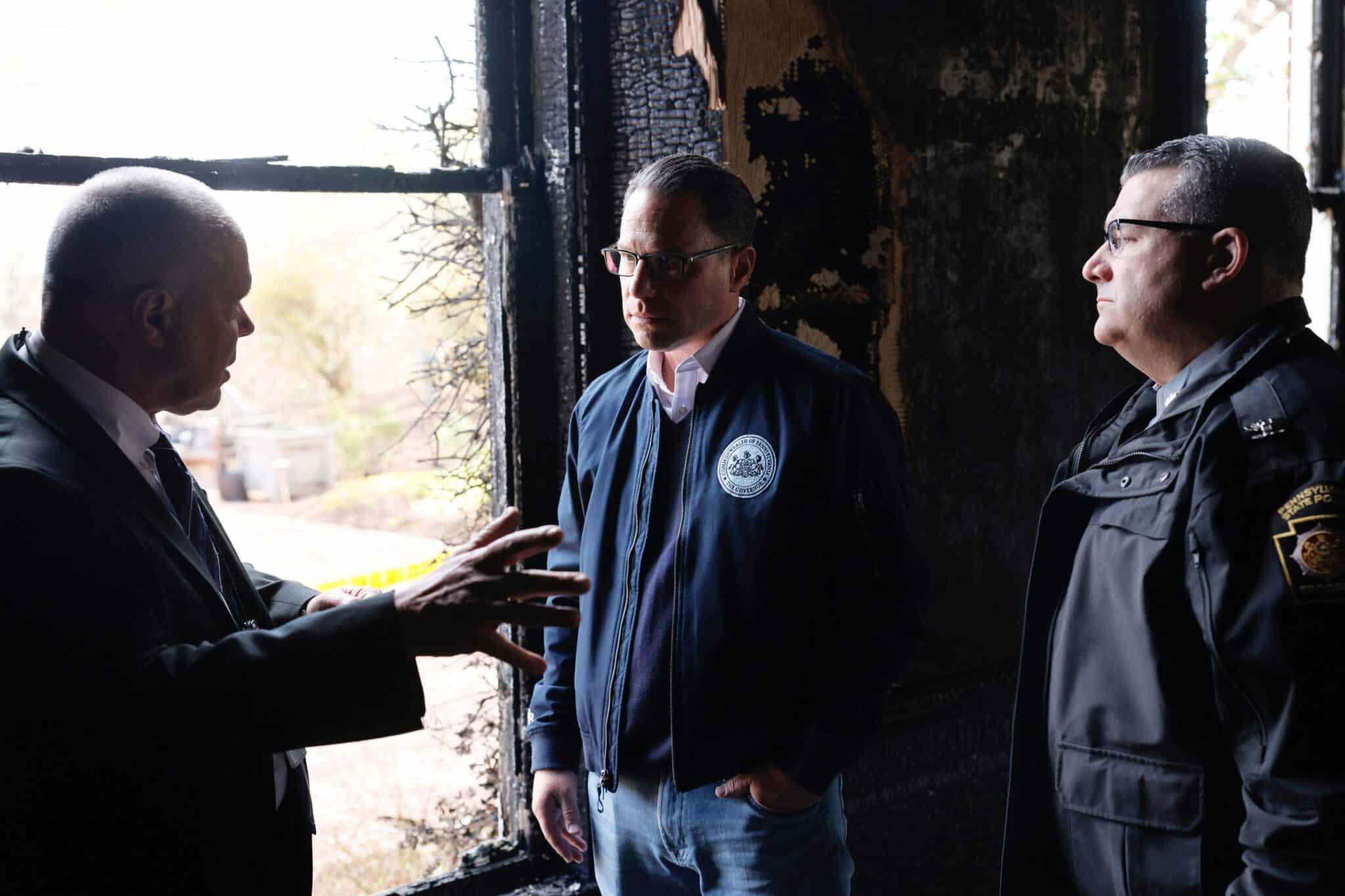Before looking at the first key moment in the life of St. Francis of Assisi, let’s set the stage by focusing on his early life. Francis was born in 1182 in Assisi. He was the son of a prosperous cloth merchant, Peter Bernadone. His companions saw him as a carefree youth, calling him the “King of Revels.”
Francis enjoyed partying with his friends and had dreams of becoming a knight and gaining glory on the battlefield. But shortly after riding off to fight against Perugia, a nearby town, he ended up in their prison, a broken and disillusioned young man. It was after his return from prison, and during the recovery that followed, that Francis’ life was changed.
1) Francis Meets a Leper. Like most of his contemporaries, Francis felt a disdain for lepers and avoided them at all costs. One day, before his conversion, Francis was riding his horse alone in the countryside. As he moved along the road, he caught sight of a leper walking toward him. Francis’ instinct was to turn back or move off to the side to avoid contact with the poor wretch. But Francis instead rode directly toward this man with parts of his face and hands eaten away by this dreaded disease.
Francis dismounted his horse, and warmly embraced and kissed the leper tenderly on his lips. In his Testament, Francis writes, “When I was in sin, the sight of lepers nauseated me beyond measure; but then God himself led me into their company, and I had pity on them. When I had once become acquainted with them, what had previously nauseated me became a source of physical consolation for me. After that I did not wait long before leaving the world.” Francis eventually came to realize that he had actually embraced none other than his Lord, Jesus Christ.
Francis soon found himself living with lepers and caring for them. His meeting and embracing the leper was the best preparation Francis could have had for the founding of a new order in the Church, whose highest ideal was to serve the poorest of the poor.
Some time later, Francis was praying alone in front of a crucifix in the abandoned chapel of San Damiano, located down the hill from Assisi. Suddenly, Francis heard these words of Christ coming from the cross: “Francis, repair my house, which is falling into ruin.” Francis realized later that it was a much bigger house—the Christian Church itself—that Christ was asking him to rebuild.
2) Francis Breaks with His Father. Not long after this, Francis, dressed in rough clothing, took precious merchandise from his father’s store and sold it to his customers, in order to pay for the rebuilding of the fallen-down chapel. He also sold his father’s horse. Francis’ father, Peter, would have preferred to see Francis go back to wearing fancy attire and throwing parties for his old chums. He was aghast and embarrassed, moreover, to learn that Francis was often caring for the lepers, who were living in the valley below Assisi.
In response, his father, boiling with rage, dragged Francis before the bishop of Assisi and demanded the return of his property and goods. Francis readily agreed to this. In the hearing of all present, Francis said, “From now on I will no longer say, My Father Peter Bernadone, but Our Father who art in heaven.” Francis gave back to his father not only his property and goods, but the money and all his clothes as well. Francis carefully placed his clothing on the ground.
The bishop, admiring Francis’ fervor, drew him into his arms and covered him with his mantle. The bishop understood that Francis’ actions were inspired by God—and were part of God’s way of leading Francis into an amazingly new form of life. Francis’ heart was overflowing with joy. His heavenly Father had set him free of all attachment to earthly things.
Francis was now ready to serve the Lord simply and without fear. For all who follow St. Francis of Assisi today, this kind of poverty and detachment can lead to the freedom to, in St. Matthew’s words, become “children of your heavenly Father, for he makes his sun rise on the bad and the good, and causes rain to fall on the just and the unjust. . . . So be perfect, just as your heavenly Father is perfect” (5:45, 48).
3) Francis, the Herald of the Great King. Francis, who used to wear fine garments, now went about clad in the poorest of clothing. As he went through a nearby woods, singing praises to the Lord in French, robbers suddenly rushed out upon him. When they asked him gruffly who he was, Francis replied confidently in a loud voice, “I am the herald of the great King!” Then they struck him again and again, and threw him into a ditch filled with deep snow, saying, “Just lie there in the snow, ‘Herald of the great King!’”
But Francis simply brushed off the snow. And when they had gone away, he jumped out of the ditch, and with great joy began to call out the praises of God in a loud voice. Francis then walked along until he came to the steps of a monastery, where he hoped the monks might clothe him in exchange for work. They did so, but Francis only stayed with them for a short while.
This whole episode seemed only to reinforce Francis’ sense of freedom and his trust in the providence of God. He would need to cultivate this spirit more and more because he would still face harsher challenges in the days ahead. True followers of St. Francis today remain conscious of their great mission: to be “Heralds of the great King.”
In St. Paul’s Letter to the Philippians, we find echoes of this lofty ideal: Christ Jesus “emptied himself, taking the form of a slave, coming in human likeness . . . he humbled himself, becoming obedient to death, even death on a cross. Because of this, God greatly exalted him. . .” (2:7-9).
Guided by the Holy Spirit, St. Francis’ followers still strive to seek this ideal today!

4) Francis Spends a Night in Prayer. Bernard of Quintavalle was the first brother to follow Francis and his simple way of life. A wealthy Assisian, Bernard sold all his possessions and gave the money to the poor. He was ready to throw in his lot with Francis, but first he wanted to test Francis’ holiness. One evening, Bernard invited Francis to join him for supper at his home. After a pleasant meal, Bernard invited him to stay overnight.
Bernard had a bed prepared for Francis in his own room. Shortly after Francis entered the room, he threw himself down and pretended to fall asleep. A short time later, Bernard went to bed and also pretended to sleep—with snores and all. His plan was to watch Francis carefully during the night.
With Bernard secretly observing him, Francis got onto his knees and raised his hands in prayer. Then Bernard was amazed to hear Francis earnestly repeating throughout the night “My God and my all!” The Little Flowers of St. Francis informs us that St. Francis repeated the words while marveling at and contemplating the goodness of Almighty God (Omnibus of Sources, p. 1303).
Time and again, God’s goodness and love amazed Francis. In a prayer from his Praises Before the Office, St. Francis suddenly begins repeating the word good, almost as if intoxicated by it: “All powerful, all holy, most high and supreme God, sovereign good, all good, every good, you who alone are good, it is to you we must give all praise, all glory, all thanks, all honor, all blessing; to you we must refer all good always. Amen.”
5) Clare Enters the Franciscan Family. The daughter of a noble Assisian family, Clare was known for her love of God and of the poor. She was attracted to the Gospel way of life preached by St. Francis. Secretly in the dark of night, to the dismay of her wealthy family, Clare met with Francis and his small band of brothers to commit her life totally to God. There in the Portiuncula chapel, she exchanged her golden hair for a simple habit. She would soon begin a quickly growing community of contemplative women devoted to living the Gospel.
Clare remained a close friend and associate of St. Francis, even though she was committed to staying in her monastery alongside the other Poor Clare nuns, named after their foundress. St. Clare died in 1253, outliving her great friend Francis by almost 27 years. Until her death, Clare kept her ideals: a passion for prayer, a life of poverty and humility, and a generous concern for the needy.
The close bond between the Poor Clares and the Franciscan friars remains strong and joyful in our day. The Clares serve as vibrant models of intense union with God, which all Franciscans—and indeed all human beings— are meant to foster, as the Holy Spirit prompts.
6) Francis Receives the Stigmata. Today the Chapel of the Stigmata sits on the same sheer precipice where St. Francis stood two years before his death. There he was swept up into the mystery of God’s overwhelming love for him and for humanity.
St. Bonaventure, an early Franciscan leader and theologian, in his Life of St. Francis, describes Francis as being more inflamed than usual with the love of God as he began a special time of solitary prayer on Mount La Verna in September 1224. “Francis’ unquenchable fire of love for the good Jesus,” Bonaventure writes, “was fanned into such a blaze of flames that many waters could not quench so powerful a love” (see Song of Songs 8:6-7).
St. Bonaventure goes on: “While Francis was praying on the mountainside, he saw a Seraph, with six fiery and shining wings, descend from the height of heaven. And when in swift flight the Seraph had reached a spot in the air near the man of God, there appeared between the wings the figure of a man crucified, with his hands and feet extended in the form of a cross and fastened to a cross. Two of the wings were lifted above his head, two were extended for flight and two covered his whole body.
“When Francis saw this, he was overwhelmed and his heart was flooded with a mixture of joy and sorrow. He rejoiced because of the gracious way Christ looked upon him under the appearance of a seraph, but the fact that he was fastened to a cross pierced his soul with a sword of compassionate sorrow (Luke 2:35).” When the vision disappeared, writes Bonaventure, “imprinted on his body were markings that were no less marvelous.” These markings were the stigmata—the five wounds of Christ.
What did St. Francis experience? The simple servant of God had suddenly understood in a flash the unimaginable love of God, a love that holds nothing back from us—not even God’s only son. Many religious thinkers see this as the secret of St. Francis’ spirituality, namely, Francis’ profound appreciation for the overflowing love of God!
7) The Death of St. Francis. When Francis of Assisi’s days on earth were growing short, according Thomas of Celano, his first biographer, the saint instructed his brothers, “When I am dying, lay me naked on the ground . . . and let me lie there after I am dead for the length of time it takes to walk one mile unhurriedly” (Second Life of St. Francis of Assisi, Vol. 1, CLXIII, Omnibus of Sources).
Francis’ brothers honored his request. They reverently placed his body on the ground and let it lie there for some 30 minutes. Not long before he took his last breath, Francis invited all creatures to praise God, as the saint had so often done in his Canticle of Brother Sun (also known as the Canticle of the Creatures). Yes, Francis wanted to exhort all his “brother” and “sister” creatures to praise and love God.
The gesture of Francis lying naked on Mother Earth strikingly reveals how comfortable Francis had become with the whole world of creation, including his human body. Like Adam before the fall, Francis was not ashamed of his nakedness. Francis had become keenly aware that Jesus, in his incarnation, had entered our world and transformed the earth (and the human form) through his saving presence among us. St. Francis had come to believe that both the earth and his body—through the incarnation of Christ—had become profoundly good.
St. Francis often said to his followers, “What a man is before God, that he is and no more.” With great humility, Francis had often applied these words to himself.
As many of us know, when Francis lay there on the earth, he was bearing on his body the stigmata—the brand marks of Christ. These sacred marks remind us how closely Francis had become identified with Christ. He was also filled with awe because of Christ’s overflowing love: As we read in John 15:13, “No one has greater love than this, to lay down one’s life for one’s friends.”
Our reflections on St. Francis’ death end with a few short passages from St. Bonaventure’s Life of St. Francis: “At last, when all of God’s mysteries were fulfilled in him,” writes Bonaventure, “the blessed man fell asleep in the Lord. One of his brothers and disciples saw his soul under the appearance of a radiant star being carried aloft in a shining cloud over many waters on a direct path into heaven.”
Finally Bonaventure describes a gathering of larks which appeared “at the hour of the holy man’s passing. . . . They came in a great flock over the roof of the house and, whirling around for a long time with unusual joy, gave clear and evident testimony of the glory of the saint, who so often invited them to praise God.”
The image of those larks is an invitation to us all.








4 thoughts on “7 Key Moments in the Life of St. Francis”
Pingback: S11 Episode 54- You did it to me
Thank you for sharing this. I like reading articles that help me to have positive vibes. Keep on posting!
Thank you for these. First hearing these in formation for OFS, as well as other Francis stories, provided important and deeply spiritual pique to my own journey. Re-hearing them calls up all that in surprising ways, as these stories continue to teach me. OFS sister
Whilst living in Italy we decided to visit Assisi. The main cathedral piazza was full of visitors. I noticed a small group walking into a small building in the corner of the piazza. I joined them and inside were pictures of St Francis’s life. The first showed him as a child with his beautifully dressed wealthy family followed by pictures of him growing up. The last picture, there he was as a poor man. I looked back to see his once wealth and looked at him thinking what on earth made you change from that to this? In an instant, it felt like I was being lifted feeling an incredible joyous love that was not earthly. Tears filled my eyes and a joy filled my heart. I walked out dazed. That has taught me so much and opened my understanding of life and the Lord. Thank you St Francis.